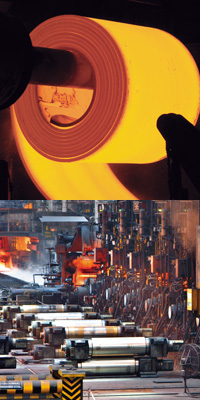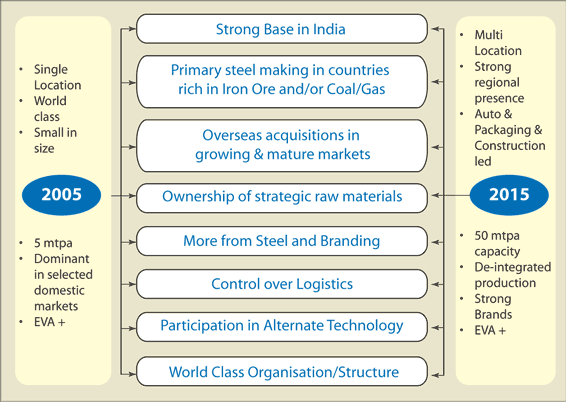 |
|
|
Management Discussion and Analysis
The Management’s discussions on the Steel Industry and the
Company’s performance are given below:
1. Steel Business Unit

India’s apparent steel consumption grew by 11.7%
to 43.8 million tonnes. |
A) Global Steel Industry Overview
Global crude steel output, which closely tracks demand, grew
by 8.9% to 1,244 million tonnes in 2006 as compared to 1,142
million tonnes in 2005 mainly driven by strong growth of
18% in China. In 2006, the top five steel producing countries
were China (422.7 million tonnes), Japan (116.2 million
tonnes), USA (98.6 million tonnes), Russia (70.8 million tonnes)
and South Korea (48.5 million tonnes). The finished steel
consumption grew by 8.5% at 1,113 million tonnes in 2006 as
compared to 1,026 million tonnes in 2005. China accounted for
33% of global steel consumption and 50% of global demand
growth. The Asian region especially China witnessed the most
remarkable growth over the past ten years. In 1996, China
produced 101 million tonnes of crude steel. By 2001, crude
steel production increased to 151 million tonnes, at a CAGR of 8%. In 2006, China produced 422.7 million tonnes of crude
steel, registering a CAGR of 23% in last five years. China’s share
of world crude steel production also increased exponentially.
In 1996, China became the largest steel producing country
in the world for the first time, accounting for 13.5% of global
crude steel production. In 2006, this share increased to around
one third of the total crude steel produced in the world.
The global steel consumption increased both in developing
and developed countries in 2006, with double digit growth in
Europe, CIS, NAFTA and South and Central America. In Europe,
the increase in demand was accompanied by a substantial
increase in steel imports primarily from China, which emerged
as a significant net exporter of steel in 2006. Construction was
the key driver of demand across the EU in 2006, notably in
Germany, which recovered very strongly.
The demand for raw materials viz. iron ore, coal, scrap,
energy etc. have increased significantly due to robust
growth in global crude steel production led by China. The
shortages of raw materials and constraints of logistics, led to
increase in prices of raw materials. Iron ore prices increased
for the last five years consecutively. Iron ore fines prices
increased by 19% in 2006, 71.5% in 2005, 18.6% in 2004
and 9% in 2003. There is a further increase in contracted
prices of iron ore fines by 9.5% in 2007. China’s crude steel
production increased by 18% or 63 million tonnes in 2006
and to support this production, iron ore imports into China
increased by 19%. In order to respond to the tightening
supply-demand balance, major iron ore and coal producers
are investing in new mines to increase production capacity.
The hard coking coal prices decreased by 7% in 2006, after
a steep increase by 117% in 2005 and 24% in 2004. There
is a further decline in the contracted prices of hard coking
coal in 2007 due to increased supply coming on stream. The
steel industry and all commodities related industries have
witnessed an upward shift in their respective cost curves
and hence prices for both raw materials and steel products
are likely to settle at much higher levels than the average
prices that prevailed in the past.
B) Domestic Steel Industry Overview
Indian Steel Industry registered a strong growth in steel
consumption driven by strong growth in all steel consuming sectors viz. automotive (13.6%), capital goods (18.3%),
construction (10.7%), consumer non-durables (10.5%)
and consumer durables (9.1%) etc. During the fiscal year
2006-07, India’s apparent steel consumption grew by 11.7% to 43.8 million tonnes. The flat products and long products
consumption grew by 11.5% and 12.3% respectively. Domestic
steel production grew by 11.1% to 49.4 million tonnes. Steel
exports grew by 6.1% to 4.7 million tonnes and steel imports
increased by 6.4% to 4.1 million tonnes.
C) Steel Industry Outlook for 2007-08
Driven by the continued growth in developing and emerging
economies, global growth is likely to remain robust. World GDP is expected to grow by 3.4% in 2007. China and India are
expected to continue its march towards high growth, though controlling inflationary pressures may be a challenge for the
Indian Government.
The International Iron and Steel Institute (IISI) forecasts global
steel consumption to grow by 5.9% in 2007 and 6.1% in 2008,
driven by strong demand from Asia, Africa and South America.
The apparent steel demand is likely to increase by 65 million
tonnes in 2007 and 72 million tonnes in 2008 to reach a level
of 1,250 million tonnes in 2008. China is expected to remain
the largest market with steel demand likely to increase by 13%
(46 million tonnes) in 2007, which represents 71% of global
steel consumption growth in 2007.
| |
Apparent Steel Demand |
Growth |
| 2006 |
2007(F) |
2008(F) |
2006/07 |
2007/08 |
| European Union (25) |
184.7 |
187.4 |
191.0 |
1.5% |
1.9% |
| Other Europe |
27.9 |
29.8 |
31.7 |
6.5% |
6.4% |
| C.I.S. |
48.4 |
51.4 |
54.4 |
6.1% |
6% |
| N.A.F.T.A. |
154.9 |
150.1 |
156.6 |
-3.1% |
4.3% |
| Central & South America |
36.0 |
38.2 |
40.5 |
6.1% |
6% |
| Africa |
21.6 |
23.1 |
24.9 |
6.95 |
7.8% |
| Middle East |
36.8 |
40.2 |
43.6 |
9.1% |
8.4% |
| China |
356.2 |
402.5 |
442.8 |
13% |
10% |
| India |
43.1 |
47.5 |
52.8 |
10.2% |
11.2% |
| Asia excl. India & China |
195.6 |
200.5 |
204.4 |
2.5% |
1.9% |
| Oceania |
7.9 |
8.0 |
8.0 |
1.8% |
0% |
| World |
1113.2 |
1178.7 |
1250.6 |
5.9% |
6.1% |
| World exc. China |
756.9 |
776.1 |
807.8 |
2.5% |
4.1% |
Source: IISI, March 2007
The Indian Steel Industry is now believed to be
at an inflexion point. It is poised for a demand
growth of 10% in FY 2007-08. Demand for flat
products and long products is expected to
grow by 12% and 9% respectively.
Rise in personal disposable incomes and
easy access to funds from banks has led to
new housing projects in last 3-5 years. The
Automotive sector also grew at a significant
rate of over 15% due to easy availability of
consumer finance, excise duty reduction and
higher disposal income with households.
Recent increase in interest rates is likely to
dampen this sentiment somewhat, but the
growth rate is likely to remain robust.
The Committee on Infrastructure in India constituted under the
Chairmanship of the Prime Minister in August 2004 planned
for an expenditure of approximately Rs. 14,50,000 crores
(USD 320 billion) in the 11th Five Year Plan (2007-2012) on
Irrigation, Urban Infrastructure, Power, Roads, Railways, Ports,
Airports, Telecom projects etc. This may lead to increased steel
consumption in foreseeable future. India’s steel consumption is
expected to increase to 65 million tonnes by FY 2009-10 and
over 125 million tonnes by FY 2014-15.
D) Tata Steel’s Growth Strategy
During the 1990s, the Company re-engineered its business
processes, established its cost leadership in a liberalised scenario and modernised its operations to become one of
the most efficient steel producers in the world. After a period
of recessionary conditions in the early part of the century, the
steel industry scenario changed dramatically in 2003 led by
the strong growth in China. The Company was prepared to
participate in this opportunity and set out on the growth and
globalisation path in the 21st century.
The Company realised the need to grow in size and regional
diversity to match global players. In 2005, the Company made
long term plans of becoming a 50 million tonne steel producer
by 2015 having multi-locational manufacturing facilities
with strong regional presence focusing mainly on auto,
packaging and construction sectors across the global markets.
The long term growth plans of Tata Steel are focused on the
following levers:

TOP |
|
 |